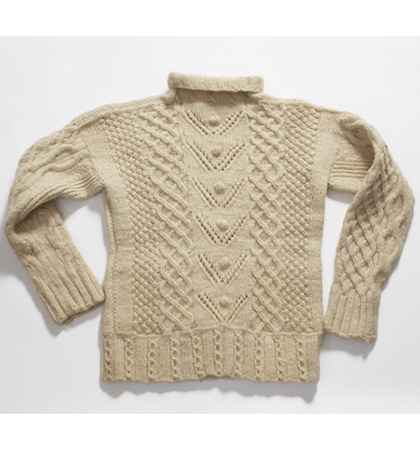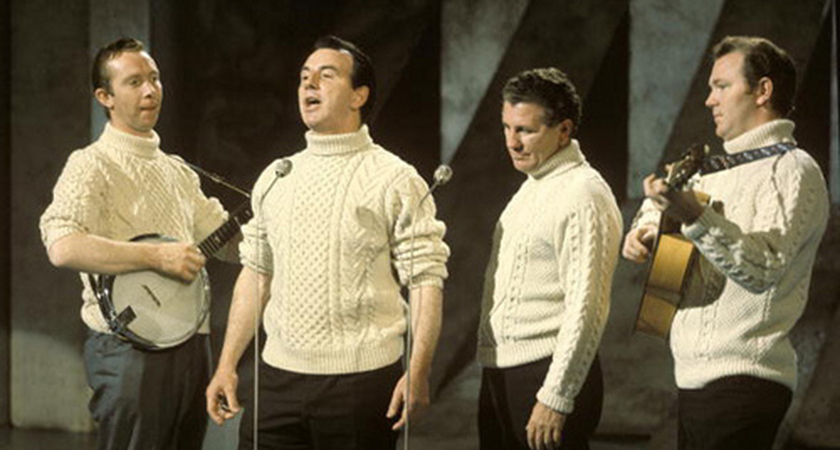AN IRISH childhood staple will featured in a new exhibition because it has has had a profound impact on the world over the last century.
The humble Aran jumper is to be featured alongside over 100 fashion items in the 'Is Fashion Modern?' exhibit at the Museum of Modern Art (MoMA) in New York.
The exhibition will explore 111 of the most iconic fashion garments and accessories over the last century from October until January 2018.
Aran jumpers originated on the Aran islands off Co. Galway for fisherman to wear in all weather conditions.
They had individual stitches and patterns on their knitted jumpers according to their family to enable them to be identified if they were had the misfortune to be washed up by the sea.
According to MoMA, each of the 111 items explored in the exhibition were selected because they have had a “profound impact on the world over the last century."
To contribute to the exhibit, an Aran jumper from the National Museum of Ireland - Country Life in Co. Mayo, will feature.
The history and impact of the Aran jumper will be explored alongside a host of well-known fashion designs such an example of the biker jacket from the 1950s; a Wonderbra; a Birkin bag; a 1960s Breton shirt; a pair of Levi’s 501 jeans from the 1940s; and a collection of little black dresses.
The Aran jumper being featured is a cream, knitted piece from 1940 - made from a heavy, scoured wool.
 This Aran jumper, above, will be featured in the MoMA exhibit. (Picture: National Museum of Ireland)
This Aran jumper, above, will be featured in the MoMA exhibit. (Picture: National Museum of Ireland)The patterns are different front and back, as the centre panel on one side has a diamond stitch and the centre of the other side consists of a trellis openwork pattern with bobbles.
It was last exhibited in 2008 at the National Museum of Ireland - Country Life as part of the exhibition Romantic Stitches and Realistic Sketches.
Aran jumpers have long been a highly recognisable symbol abroad of the romanticism of Irish rural life and Irish folk art.
They became particularly popular from the 1950s onwards when they began to be exported in their thousands from Ireland to shops in America, Europe and Japan.
They also have an association with Irish folk singers the Clancy Brothers and Tommy Makem, achieving huge popularity internationally.
Read everything you need to know about the Aran Jumper here
Clodagh Doyle, curator at the National Museum of Ireland – Country Life, who has coordinated the loan of the Aran jumper, said the jumper is part of Ireland's folk heritage.
"It is magnificent that a piece of our folk heritage will represent our country and one of our traditional crafts in this exhibition of ground-breaking fashion essentials," she said.
"This Aran jumper came into the National Museum of Ireland in 1942 from the Irish Homespun Society, which was founded by Muriel Gahan.
"Irish knitwear design has come along way since she set up The Country Shop in 1930 to sell home crafts in a flagship Dublin store.”
Tony Candon, Manager and Keeper of the National Museum of Ireland – Country Life, said celebrities helped to popularise the Aran jumper internationally.
"Through their association with the Irish folk singers, the Clancy Brothers and Tommy Makem, they achieved huge international popularity and were worn by celebrities such as Steve McQueen and Grace Kelly," explained Mr Candon.
 The jumpers received worldwide recognition, party through the association with the Clancy Brothers. (Picture: National Museum of Ireland)
The jumpers received worldwide recognition, party through the association with the Clancy Brothers. (Picture: National Museum of Ireland)"Aran sweaters continue to be popular today though are now made in materials other than just wool and can also be machine-knit or hand-knit.
“We are pleased to be able to contribute to this exciting new exhibition in the Museum of Modern Art in New York. Aran sweaters are a powerful expression of the creativity of the Irish folk craft tradition and we are very happy that this is being recognised through inclusion in this important exhibition."
Announcing the exhibition, Paola Antonelli, Senior Curator, Department of Architecture and Design, MoMA, said fashion is a "powerful form of creative and personal expression".
“Like all physical and digital forms of design, it moves today on a spectrum ranging from post-industrial seriality, from prêt-à-porter to fast fashion, to precious, handcrafted uniqueness, such as couture.
"As design, it exists in the service of others. In most cases, it is designed by a human being to dress others - sometimes many, many others - so that they can function in the world, in different arenas.”

